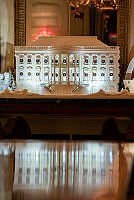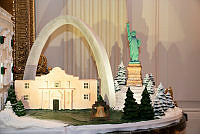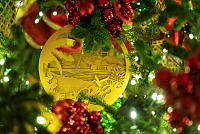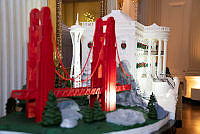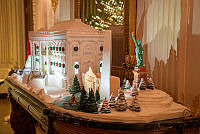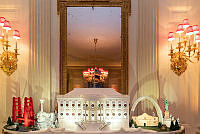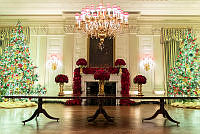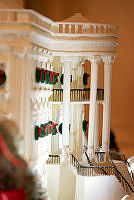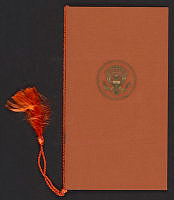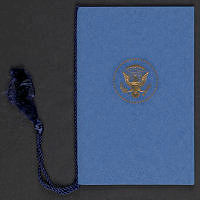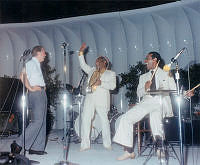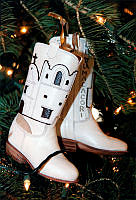Rubenstein Center Scholarship
Upstairs at the White House with Tricia Nixon
This month marks the 50th anniversary of Upstairs at the White House with Tricia Nixon, a historic White House television event with the now iconic CBS television news show, 60 Minutes. While Harry Truman, Jacqueline Kennedy, and Claudia “Lady Bird” Johnson had previously conducted recorded tours of the White House, this was the first time that cameras were allowed upstairs for a televised tour of the First Family’s living quarters. First Daughter, Tricia Nixon Cox, recalled that both of her parents, President Richard Nixon and First Lady Patricia Nixon, honored the show’s request for a televised tour because they thought it was a good idea saying, “It was important to both my parents to make the White House as accessible as possible. I remember my parents especially loved the idea of sharing the Private Quarters of the home.”1

This behind-the-scenes photograph of Tricia Nixon's "60 Minutes" tour of the White House was taken on April 25, 1970 by James E. Russell. Nixon, the eldest daughter of President Richard M. Nixon and First Lady Pat Nixon, guided reporters Harry Reasoner and Mike Wallace through the living quarters used by the First Family, including rooms not often seen by the public. In this photograph, Nixon stands with Wallace and Reasoner in the Center Hall. The tour was broadcast on May 26, 1970.
White House Historical AssociationIn 1970, we did not have the Facebook Live, Instagram, YouTube, the White House Historical Association’s White House Experience App, or even the internet with websites devoted to showing us all the beautiful interiors of the People’s House. Images of the White House were not a simple click away on our smart phones, so being able to see inside 1600 Pennsylvania Avenue was a rare moment to cherish. Outside of photographs from magazines on the whole, most Americans were still not able to go inside the White House even if they were fortunate enough to go on a public East Wing tour, or be invited for a social event, as they were still relegated to the public State Floor. This unique building that acts as a home, office, and museum had largely been limited so being able to have unfettered access to every room would be an amazing treat.
Every first family leaves their own personal imprint on the White House to make it their own. Some make dramatic changes and others make very few public enhancements. However, in the 1960s the home received a much-needed injection of life by a new young first family and the home was revolutionized in the minds of Americans. “President and Mrs. Kennedy not only restored the White House to its former glory, but they also introduced a new way to convey the message of its distinguished past,” said the late American historian William Seale. “People always knew the White House was special, but the Kennedys brought it out of our collective imagination and into reality. That was their greatest gift to this country.”2

This photograph by James E. Russell shows Tricia Nixon speaking with CBS News reporters Mike Wallace and Harry Reasoner on the Truman Balcony. Nixon gave a tour of the White House as part of a segment for the news program "60 Minutes that was broadcast on May 26, 1970. A Norelco television camera and a boom mike indicate the conversation was part of the recording. The White House south grounds, the Washington Monument and Jefferson Monument are all visible from President Truman's 1948 addition to the house.
White House Historical AssociationFirst Lady Jacqueline Kennedy created the White House Historical Association and the process to bring historic pieces back into the house, and therefore Americans became increasingly intrigued by the home. This sentiment was fueled in addition by the first lady giving the first televised tour of the State Floor of the White House on Valentine’s Day 1962. Americans were more enthralled with the home than ever before and they wanted to see more. It was First Lady Pat Nixon that answered the call to share the White House, both its public and private spaces, to more people than ever before both through increasing access to tours and special events, but also through this televised special.
CBS anchors Mike Wallace and Harry Reasoner began this special televised tour in the First Daughter’s favorite space of the White House, the Truman Balcony. To this day Tricia fondly remembers how her family enjoyed being outside, watching Americans stop and look up as they would wave to one another. Tricia shared with the viewers how the entire Nixon family loved eating alfresco dinners there with the amazing view overlooking the South Lawn, the Washington Monument, and Potomac River. Following closely behind Tricia the cameras moved inside into her mother’s favorite area, the Yellow Oval Room.

This photograph by James E. Russell shows Tricia Nixon guiding the CBS tour to the Yellow Oval Room with reporters Mike Wallace and Harry Reasoner. Nixon gave a tour of the White House as part of a segment for the news program "60 Minutes that was broadcast on May 26, 1970.
White House Historical AssociationSpecial items were shared including her mother’s golden four-leaf lucky clover paperweight kept in Mrs. Nixon’s sitting room, which lead to stories about the first lady preferring to celebrate her birthday the day after, on Saint Patrick’s Day, so that they could include her Irish heritage. Viewers saw gifts from foreign heads of state including a clock from former French President Charles de Gaulle. This part of the tour proved that Tricia was a “natural” for TV, according to CBS producer Don Hewitt, who taped the tour. When Harry Reasoner pointed out that the state gift was not telling time correctly the Washington Post, and Times Herald, reported “The CBS crew, out of camera range, winced. They expected Tricia to get flustered. Instead, she just dimpled and replied: “Well, that just proves this was an unrehearsed show.”3 Unphased, Tricia continued to win over the viewers by sharing more about the first family. She even included less significant items such as hollowed out Easter Egg frames created by a well-wisher that had photographs of the president, first lady, sister Julie, brother-in-law David, and herself displayed inside.
As Tricia guided them through the hallway, she revealed that her mother “really took a personal hand in decorating this floor. We lived in many homes all over the country, and from each one my mother is proud to bring a bit of our personalities and I think that’s what makes for an interesting home… when you can see what the interests of the people are and what their tastes are.”4 Unlike Mrs. Kennedy’s famous televised tour of the White House, this tour was in color allowing Americans to see all of the vibrant fabrics, paintings, and colors inside the People’s House. In one segment, Tricia pointed out that Mrs. Nixon had hand selected the new yellow paint down a hallway saying “she wanted to bring a bit of sunlight into the hall because, as you can see, there’re no windows here, and she thought that this would be very cheerful.”5 While the shades of yellow changed through different administrations, the hall remained yellow for decades until the Barack Obama administration when it was changed to beige.

This photograph by James E. Russell shows Tricia Nixon guiding the CBS tour to the Yellow Oval Room with reporters Mike Wallace and Harry Reasoner. From this view, "Mouth of the Delaware," "Boston Harbor" and "The Forest," all artworks in the White House Collection, can be seen. Nixon gave a tour of the White House as part of a segment for the news program "60 Minutes that was broadcast on May 26, 1970.
White House Historical AssociationThe First Daughter also paid homage to the families that lived in the home before her. Tricia steered the anchors into the relatively new private dining room created by Mrs. Kennedy in 1962, where an amazing Jean Zuber wallpaper hung with depicted scenes of the American Revolution (similar to the paper in the Diplomatic Reception Room, titled Vues de l’Amerique du Nord). Tricia reflected on the room by saying, “We are really surrounded by history as we dine here…but before this room was a family dining room, it was used as a bedroom by some members of the first family. This was Tad Lincoln’s bedroom and when Mrs. Roosevelt was here to dinner not too long ago, Mrs. Longworth, who was Alice Roosevelt, Theodore Roosevelt’s daughter, she was sitting right where you’re standing, Mr. Wallace, and she exclaimed, ‘My goodness! Just to think this is the room where I had my appendix out! I spent weeks here recuperating!’ But she did have a pretty view because this room does look out onto Pennsylvania Avenue and the fountains there.”6
“With spontaneous vivacity and humor” as described by The New York Times Tricia continued the tour.7 Before this televised event, many didn’t realize how much President Nixon loved sitting and working by the many fireplaces in the White House, especially in his most favorite room, the study just off the Lincoln Bedroom. It was an important room in the White House for the Nixon administration. It was where he kept his favorite chair from their New York apartment, and King Timahoe’s (the Irish Sitter given to President Nixon by his staff for his birthday) large rawhide bone and one of the many places a box of biscuits was usually kept for the family’s three dogs. Once, when President Nixon was working into the early morning hours on a speech, he decided to light a fire much to the dismay of White House staff. Tricia said with a laugh that it “sent the White House Fire Department into an absolute panic, and they arrived here en masse, about 2:30 A.M., to find just a fire burning and my father working on a speech.”8

This photograph by James E. Russell shows Tricia Nixon guiding the CBS tour to the President's Dining Room on the second floor of the White House. The room's wall covering is the Jean Zuber et Cie wallpaper, "Scenes of the American Revolution." Nixon gave a tour of the White House as part of a segment for the news program "60 Minutes that was broadcast on May 26, 1970.
White House Historical AssociationMike Wallace ended the taped tour in the study with him asking a question about the humidor he saw in the room wondering if they contained Cuban cigars, since this was a time when tensions with Cuba were very high. Tricia responded with laughter saying Fidel Castro has not been on a State Visit so she was positive they were not Cuban.
In reflection on the airing of the program, Tricia remembers one of the greatest things about the White House is that it is such a representation of our democracy, it is on a human scale, as the home of our President. That same sentiment that she has in 2020 was shared with Mike Wallace, fifty years ago. During the taping, in the most informal room of the private residence, at the end of the hall, where the family congregated the most. Asked if it was like living in a goldfish bowl she replied, “When you are living in the White House you are on display an awful lot and it is a bit like a goldfish bowl, but it is really more like a goldfish bowl when you are out of it, than when you are in it. So, when you come home, and this is our home while my father is serving the nation, we really feel that we can relax here.”9 It is out of the large bay window of that West Sitting Hall that the family would congregate to see President Nixon working in the Oval Office for historic events like landing on the moon. First Lady Patricia Nixon, Julie, David, Tricia and Mamie Eisenhower were all in that room watching TV for the event but were also able to look out the bay window to see him phone the astronauts live.
For the Nixons, this presentation was one of the many aspects of how they successfully opened up the White House to more people during their time as its occupants. With the encouragement of Mrs. Nixon, their administration acquired more than 600 artifacts for the home making it the largest acquisition to date of any administration. "The Nixon era was the greatest single period of collecting in White House history," said William Seale, "The great collection of White House Americana today is the long shadow of Mrs. Nixon. The impulse, the idea and the energy were hers."10

This behind-the-scenes photograph of Tricia Nixon's "60 Minutes" tour of the White House was taken on April 25, 1970 by James E. Russell. Nixon, the eldest daughter of President Richard M. Nixon and First Lady Pat Nixon, guided reporters Harry Reasoner and Mike Wallace through the living quarters used by the First Family, including rooms not often seen by the public. In this photograph, Nixon is seen in the Center Hall with members of "60 Minutes" crew, including producer and creator Don Hewitt. The tour was broadcast on May 26, 1970.
White House Historical AssociationThe first lady continued to find new ways of opening the White House, creating new traditions such as the White House Spring and Fall Garden tours, as well as the Christmas Candlelight tours. She also developed special tours for the blind, pamphlets in foreign languages, and oversaw the installation of wheelchair ramps, twenty years before the Americans with Disabilities Act. Even exterior spotlights were installed to beautifully illuminate the White House at night, allowing tourists to see the People’s House after dusk – this too was her idea. One of Tricia’s most vivid memories with her parents at the White House is how they would watch fireflies begin to light up the South Lawn evening sky, as she shared with the viewers at the beginning of the program, waiting for the home to be illuminated in the evening with these new spotlights, which were installed just a few short months after it aired.
60 Minutes closed this first of a kind piece on the White House with CBS anchor Harry Reasoner stating, “Most countries have a head of state like a king or ceremonial president or something, and separately, a chief of government like a prime minister. The head of state gives out medals and goes to luncheons. The prime minister makes policy. So, you can have an emotional feeling about Queen Elizabeth, even if at the moment Prime Minster Wilson infuriates you. We’re different. Our president is both head of state and chief of government. What this means is that at any moment of American history, we are interested in the White House and the White House family as a kind of national distillation of families. Our first family, no matter what controversial matters the president, as a partisan chief of government, is engaged in.”11
These words still ring true today--we are no less intrigued by America’s First Families and the home in which they reside, but our access and ability to see into the President’s House has changed through technology for the better, thanks in a large part to this groundbreaking special, Upstairs at the White House with Tricia Nixon.
Jennifer Pickens is an author and speaker. Her most recent book, Entertaining at the White House: Decades of Presidential Traditions, was published in 2019. To visit Jennifer's website, click here.














